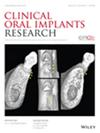Evaluating the Effects of Dynamic Navigation on the Accuracy and Outcomes of the Autogenous Bone Ring Technique for Vertical Ridge Augmentation: A Pilot Randomized Controlled Trial
Abstract
Objectives
Autogenous bone ring technique (BRT) is a one-stage vertical augmentation approach with simultaneous implant placement. The aim of this study was to compare the accuracy and efficacy of autogenous BRT assisted by dynamic navigation (DN) with freehand approach (FA) for vertical ridge augmentation.
Materials and Methods
Twenty-four patients eligible for autogenous BRT were randomly assigned to DN or FA groups. Digital preoperative design was conducted for both groups. BRT surgeries were executed with or without the aid of DN in the two groups. Accuracy outcomes evaluated angular and linear deviations at the bone ring in the donor site (BR-D), recipient site (BR-R), and implant entry/apex between planned and actual positions revealed by cone-beam computed tomography. Vertical augmentation-related outcomes, surgical complications, and patient-reported outcomes were assessed over 6 months.
Results
Twenty-four patients underwent surgery while one was lost to follow-up. The DN group showed significantly lower mean (SD) BR-R angular (3.58 [2.07] vs. 8.77 [4.20]°) and entry deviation (1.43 [0.51] vs. 2.01 [0.70] mm). For BR-D, the DN group had significantly lower angular (4.80 [2.62] vs. 12.97 [6.26]°), entry (1.45 [0.96] vs. 3.52 [1.54] mm), and apex deviation (1.28 [0.64] vs. 3.50 [1.47] mm) compared to the FA group. Implant angular deviation (3.74 [2.14] vs. 9.17 [4.39]°) and apex deviation (1.75 [0.44] vs. 2.35 [0.82] mm) was significantly lower in the DN group. In the FA group, one patient exhibited temporary lower lip hypoesthesia. No significant differences were observed in vertical bone gain, resorption, or patient-reported outcomes.
Conclusions
Compared to FA, DN may improve the accuracy of autogenous BRT procedures for vertical ridge augmentation while minimizing invasiveness.
Trail Registration
This study was registered at the Chinese Clinical Trial Registry (https://www.chictr.org.cn; Registration No. ChiCTR2200065585; registration date: 2022/11/09).

 求助内容:
求助内容: 应助结果提醒方式:
应助结果提醒方式:


